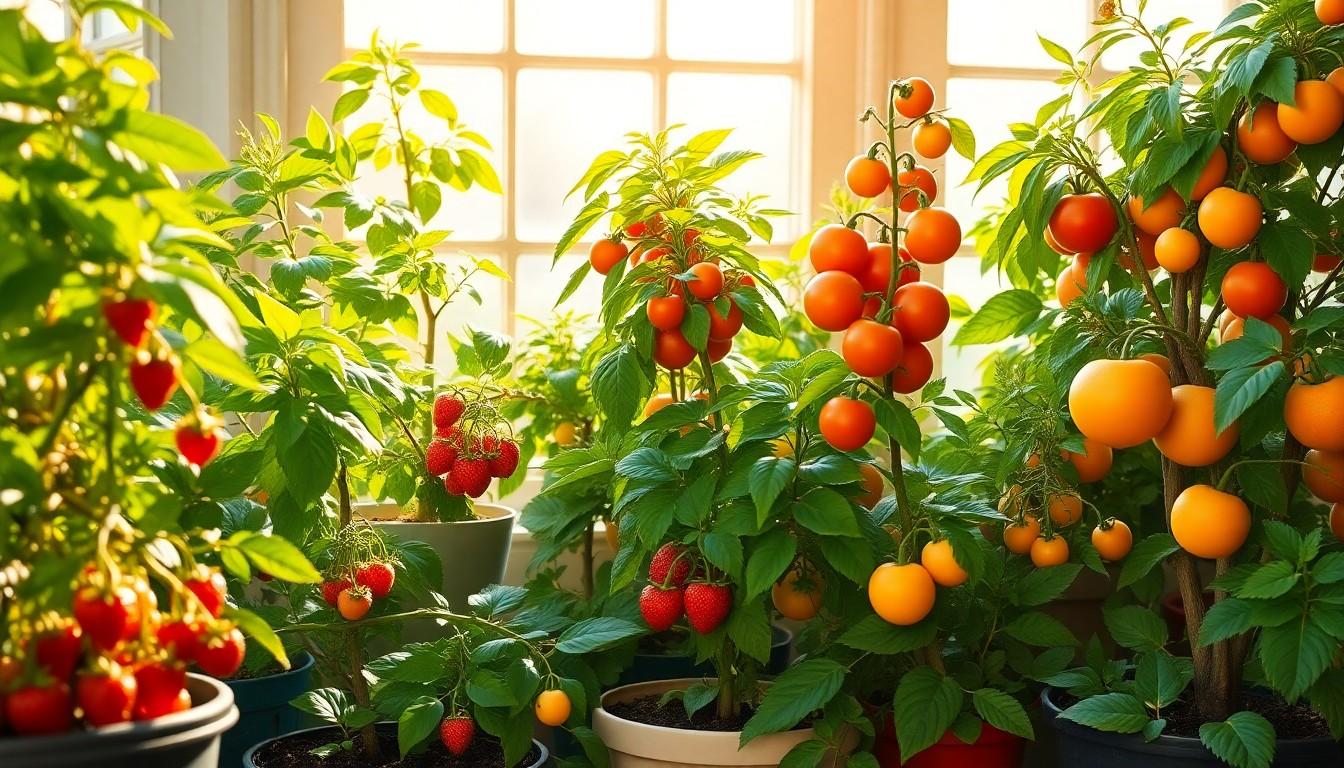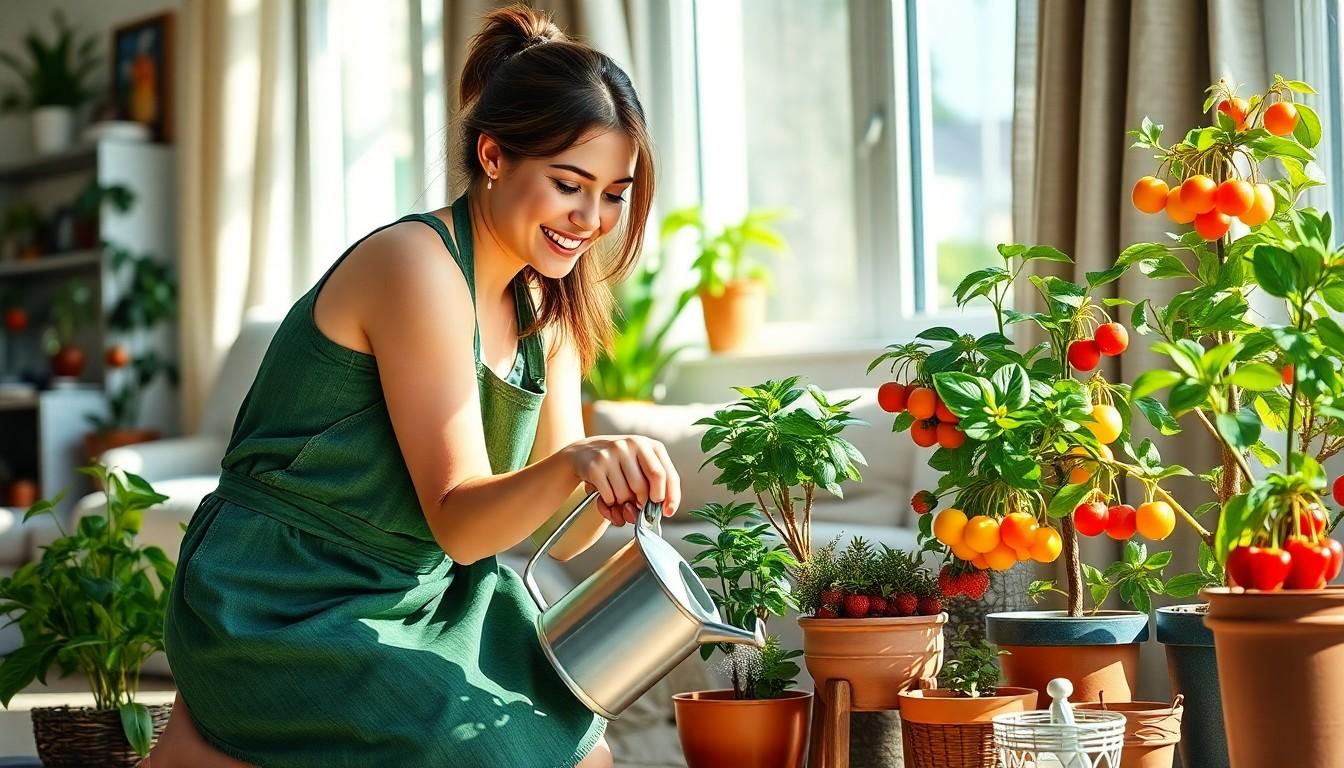Imagine plucking a ripe strawberry or a juicy lemon right from your living room. Indoor fruit plants aren’t just a quirky hobby; they’re a delicious way to bring nature indoors. With the right care, these little green wonders can transform any space into a mini orchard, all while adding a splash of color and a dash of freshness to your home.
Whether you’re a seasoned plant parent or a newbie with a questionable track record, growing fruit indoors is easier than it sounds. Forget about the hassle of outdoor gardening and the unpredictable weather. Indoor fruit plants offer a delightful blend of beauty and bounty, making it possible to enjoy homegrown goodness year-round. So why not turn your home into a fruity paradise? Let’s dive into the world of indoor fruit plants and discover how to cultivate your very own indoor Eden.
Overview Of Indoor Fruit Plants
Indoor fruit plants offer an exciting way to grow fresh produce within the comforts of home. Various species thrive in indoor conditions, making it possible for anyone to cultivate flavorful fruits year-round. Factors such as light, humidity, and temperature play an essential role in the successful growth of these plants.
Citrus plants, including dwarf lemon and lime varieties, stand out for their aromatic leaves and vibrant fruits. Strawberries, known for their sweet flavor, adapt well to pot growth and require minimal space, making them ideal for indoor gardening. Figs also flourish indoors, providing a unique taste that enhances culinary dishes.
Growing indoor fruit plants requires understanding their specific needs. Proper lighting can come from natural sunlight or grow lights, ensuring the plants receive adequate brightness. Regular watering helps maintain moisture levels, while well-draining soil prevents root rot. Fertilizers designed for fruit-bearing plants promote healthy growth and fruit production.
Many gardening enthusiasts enjoy the satisfaction of harvesting their fruits. Cultivating indoor fruit plants not only enhances home aesthetics but also provides a source of fresh produce. Engaging with gardening adds a rewarding hobby to daily life, encouraging creativity and relaxation.
Aspiring indoor gardeners should start with easy-to-grow varieties. Some popular options include cherry tomatoes, herbs like basil and mint, and even indoor raspberries. With proper care, these plants become productive and contribute to a sustainable lifestyle. Indoor gardening transforms home spaces, resulting in a mini fruit oasis.
Benefits Of Growing Indoor Fruit Plants

Growing indoor fruit plants provides numerous advantages that enhance both health and environment. The cultivation of these plants creates an enriching atmosphere at home.
Health Benefits
Indoor fruit plants offer essential nutrients through their fresh produce. Consuming homegrown fruits boosts daily vitamin intake, promoting overall health. Research indicates that homegrown fruits often contain higher levels of nutrients compared to store-bought options. Fresh fruits support immune function and digestion, contributing to a balanced diet. Additionally, the endeavor of gardening fosters physical activity, which can improve cardiovascular health. Engaging with plants also reduces stress and enhances mental well-being. Individuals cultivating these plants often develop a stronger connection to their food, leading to healthier eating habits.
Environmental Benefits
Indoor fruit plants contribute positively to indoor air quality. Plants absorb carbon dioxide and release oxygen, creating a healthier living environment. Improved air quality reduces respiratory issues and promotes better sleep. Furthermore, indoor gardening fosters a sense of biodiversity. Growing various fruit plants helps support pollinators and beneficial insects, even within homes. Utilizing sustainable practices, such as composting and organic growing methods, further reduces waste and ecological footprint. By opting for homegrown fruits, individuals decrease reliance on store-bought produce, cutting down on transportation emissions. Overall, indoor fruit plants enrich life while benefiting the planet.
Popular Indoor Fruit Plants
Numerous indoor fruit plants thrive in home settings. Below are some popular options that enhance both aesthetics and food availability.
Strawberries
Strawberries provide delicious fruits and vibrant greenery. This plant prefers bright light and temperatures above 65°F. Regular watering keeps the soil moist but not soggy. Container gardening suits strawberries well, allowing for easy movement and repositioning. Expect to harvest fruits within four to six weeks after blooming. Proper pruning of runners will encourage bushier growth. Varieties like Alpine or Everbearing are particularly suitable for indoor cultivation.
Tomatoes
Tomatoes are versatile and rewarding indoor fruit plants. They thrive in a warm environment, ideally between 70°F and 80°F. Full-spectrum grow lights significantly boost growth when natural light is insufficient. Planting dwarf varieties, such as Tiny Tim or Micro Tom, suits small spaces best. Keeping the soil consistently moist is crucial for healthy fruit development. Fruit production starts within 60 to 80 days after planting. Regular feeding with liquid fertilizers enhances yield and flavor.
Citrus Trees
Citrus trees, including lemon and lime, add a refreshing touch to indoor environments. Adequate sunlight exposure—at least 8 hours daily—is essential for thriving growth. Maintaining humidity levels around 40–50% supports optimal health for these plants. They require well-draining soil to prevent root rot. Indoor citrus trees can take about 6 to 12 months to bear fruit. Pruning encourages strong branch growth and helps shape the tree. Varieties like Meyer lemon adapt well to indoor conditions, offering aromatic fruits.
Care Tips For Indoor Fruit Plants
Caring for indoor fruit plants involves understanding their specific needs. Proper attention to light, water, and nutrition ensures successful growth.
Light Requirements
Bright, indirect sunlight is essential for most indoor fruit plants. A location next to a south or west-facing window often provides the best light conditions. Some plants, like strawberries and tomatoes, require at least 6 to 8 hours of sunlight daily. Rotating pots every few weeks helps plants receive even light exposure. If natural light falls short, consider using grow lights to supplement. Indoor fruit plants thrive in consistent light conditions, preventing leggy growth.
Watering Guidelines
Watering frequency varies among indoor fruit plants. Checking the top inch of soil before watering prevents overwatering. Most plants prefer soil that remains slightly moist but not soggy. Draining excess water from pots protects against root rot. Adjusting watering schedules according to seasonal changes supports healthy growth. During hotter months, be prepared to increase watering as plants use more moisture. Observing signs of drooping or curling leaves can indicate a need for water.
Fertilization Tips
Fertilization plays a crucial role in fruit production. Using a balanced, water-soluble fertilizer during the growing season supports healthy development. Applying fertilizer every 4 to 6 weeks typically yields positive results. Indoor fruit plants benefit from specific nutrient ratios, such as higher potassium for fruiting. Reducing feeding during the dormant winter months safeguards against over-fertilization. Following package instructions ensures proper dosage and frequency for optimal growth.
Common Challenges
Indoor fruit gardening presents distinct challenges. Addressing these issues effectively leads to healthier plants and more fruitful harvests.
Pests and Diseases
Pests and diseases pose significant threats to indoor fruit plants. Aphids, spider mites, and whiteflies frequently infest these environments, causing leaf damage and stunted growth. Regular monitoring helps catch infestations early. Implementing integrated pest management techniques, such as introducing beneficial insects and using insecticidal soap, reduces pest populations. Additionally, diseases like powdery mildew and root rot can compromise plant health. Providing adequate air circulation and ensuring proper watering practices minimizes disease risk.
Space Limitations
Space limitations often restrict indoor gardening efforts. Many indoor fruit plants thrive in limited areas, yet they occasionally outgrow their containers. Choosing compact varieties, such as dwarf citrus or small strawberry plants, proves beneficial in tight spaces. Prioritizing vertical gardening techniques, like using shelves or hanging pots, maximizes available space. Furthermore, positioning plants near windows ensures sufficient light while minimizing obstruction. Adapting to spatial constraints fosters creativity in indoor gardening while promoting healthy plants.
Conclusion
Growing indoor fruit plants offers a unique opportunity to enhance living spaces while enjoying the rewards of home gardening. With the right care and attention, anyone can cultivate a thriving indoor oasis filled with fresh, nutritious fruits.
The journey of indoor gardening not only brings joy and satisfaction but also promotes a healthier lifestyle and a stronger connection to nature. By choosing the right plants and understanding their needs, aspiring gardeners can overcome challenges and create a flourishing environment.
Embracing indoor fruit gardening leads to a sustainable lifestyle that benefits both personal well-being and the planet. Whether it’s the vibrant colors of strawberries or the refreshing scent of citrus, the beauty and bounty of indoor fruit plants can transform any home.

